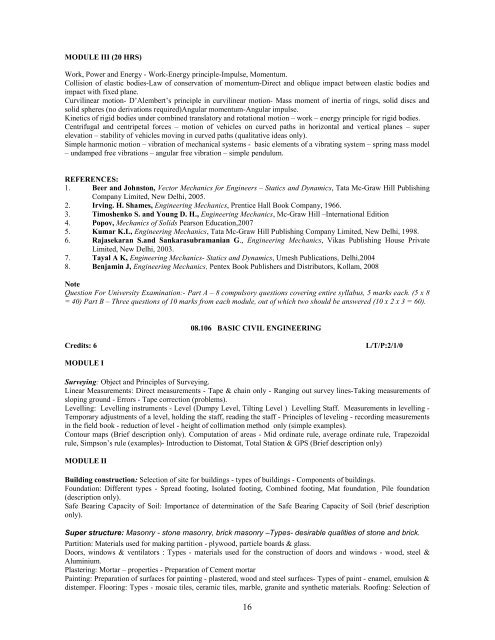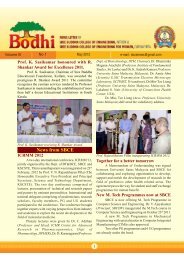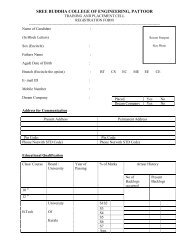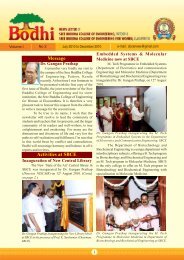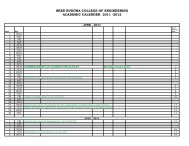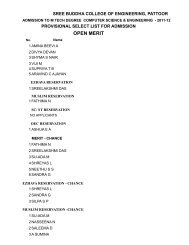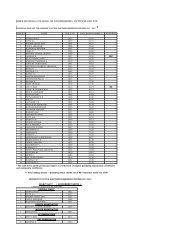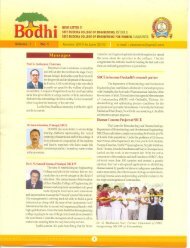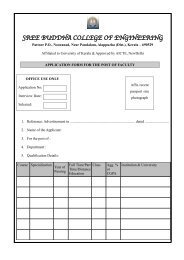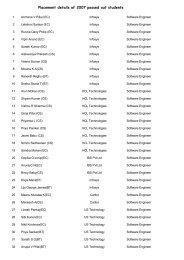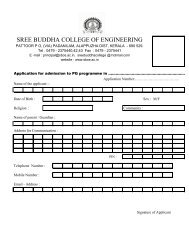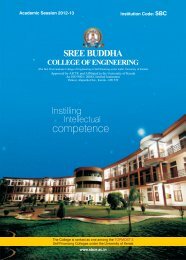UNIVERSITY OF KERALA
UNIVERSITY OF KERALA
UNIVERSITY OF KERALA
Create successful ePaper yourself
Turn your PDF publications into a flip-book with our unique Google optimized e-Paper software.
MODULE III (20 HRS)<br />
Work, Power and Energy - Work-Energy principle-Impulse, Momentum.<br />
Collision of elastic bodies-Law of conservation of momentum-Direct and oblique impact between elastic bodies and<br />
impact with fixed plane.<br />
Curvilinear motion- D’Alembert’s principle in curvilinear motion- Mass moment of inertia of rings, solid discs and<br />
solid spheres (no derivations required)Angular momentum-Angular impulse.<br />
Kinetics of rigid bodies under combined translatory and rotational motion – work – energy principle for rigid bodies.<br />
Centrifugal and centripetal forces – motion of vehicles on curved paths in horizontal and vertical planes – super<br />
elevation – stability of vehicles moving in curved paths (qualitative ideas only).<br />
Simple harmonic motion – vibration of mechanical systems - basic elements of a vibrating system – spring mass model<br />
– undamped free vibrations – angular free vibration – simple pendulum.<br />
REFERENCES:<br />
1. Beer and Johnston, Vector Mechanics for Engineers – Statics and Dynamics, Tata Mc-Graw Hill Publishing<br />
Company Limited, New Delhi, 2005.<br />
2. Irving. H. Shames, Engineering Mechanics, Prentice Hall Book Company, 1966.<br />
3. Timoshenko S. and Young D. H., Engineering Mechanics, Mc-Graw Hill –International Edition<br />
4. Popov, Mechanics of Solids Pearson Education,2007<br />
5. Kumar K.L, Engineering Mechanics, Tata Mc-Graw Hill Publishing Company Limited, New Delhi, 1998.<br />
6. Rajasekaran S.and Sankarasubramanian G., Engineering Mechanics, Vikas Publishing House Private<br />
Limited, New Delhi, 2003.<br />
7. Tayal A K, Engineering Mechanics- Statics and Dynamics, Umesh Publications, Delhi,2004<br />
8. Benjamin J, Engineering Mechanics, Pentex Book Publishers and Distributors, Kollam, 2008<br />
Note<br />
Question For University Examination:- Part A – 8 compulsory questions covering entire syllabus, 5 marks each. (5 x 8<br />
= 40) Part B – Three questions of 10 marks from each module, out of which two should be answered (10 x 2 x 3 = 60).<br />
08.106 BASIC CIVIL ENGINEERING<br />
Credits: 6<br />
L/T/P:2/1/0<br />
MODULE I<br />
Surveying: Object and Principles of Surveying.<br />
Linear Measurements: Direct measurements - Tape & chain only - Ranging out survey lines-Taking measurements of<br />
sloping ground - Errors - Tape correction (problems).<br />
Levelling: Levelling instruments - Level (Dumpy Level, Tilting Level ) Levelling Staff. Measurements in levelling -<br />
Temporary adjustments of a level, holding the staff, reading the staff - Principles of leveling - recording measurements<br />
in the field book - reduction of level - height of collimation method only (simple examples).<br />
Contour maps (Brief description only). Computation of areas - Mid ordinate rule, average ordinate rule, Trapezoidal<br />
rule, Simpson’s rule (examples)- Introduction to Distomat, Total Station & GPS (Brief description only)<br />
MODULE II<br />
Building construction: Selection of site for buildings - types of buildings - Components of buildings.<br />
Foundation: Different types - Spread footing, Isolated footing, Combined footing, Mat foundation¸ Pile foundation<br />
(description only).<br />
Safe Bearing Capacity of Soil: Importance of determination of the Safe Bearing Capacity of Soil (brief description<br />
only).<br />
Super structure: Masonry - stone masonry, brick masonry –Types- desirable qualities of stone and brick.<br />
Partition: Materials used for making partition - plywood, particle boards & glass.<br />
Doors, windows & ventilators : Types - materials used for the construction of doors and windows - wood, steel &<br />
Aluminium.<br />
Plastering: Mortar – properties - Preparation of Cement mortar<br />
Painting: Preparation of surfaces for painting - plastered, wood and steel surfaces- Types of paint - enamel, emulsion &<br />
distemper. Flooring: Types - mosaic tiles, ceramic tiles, marble, granite and synthetic materials. Roofing: Selection of<br />
16


